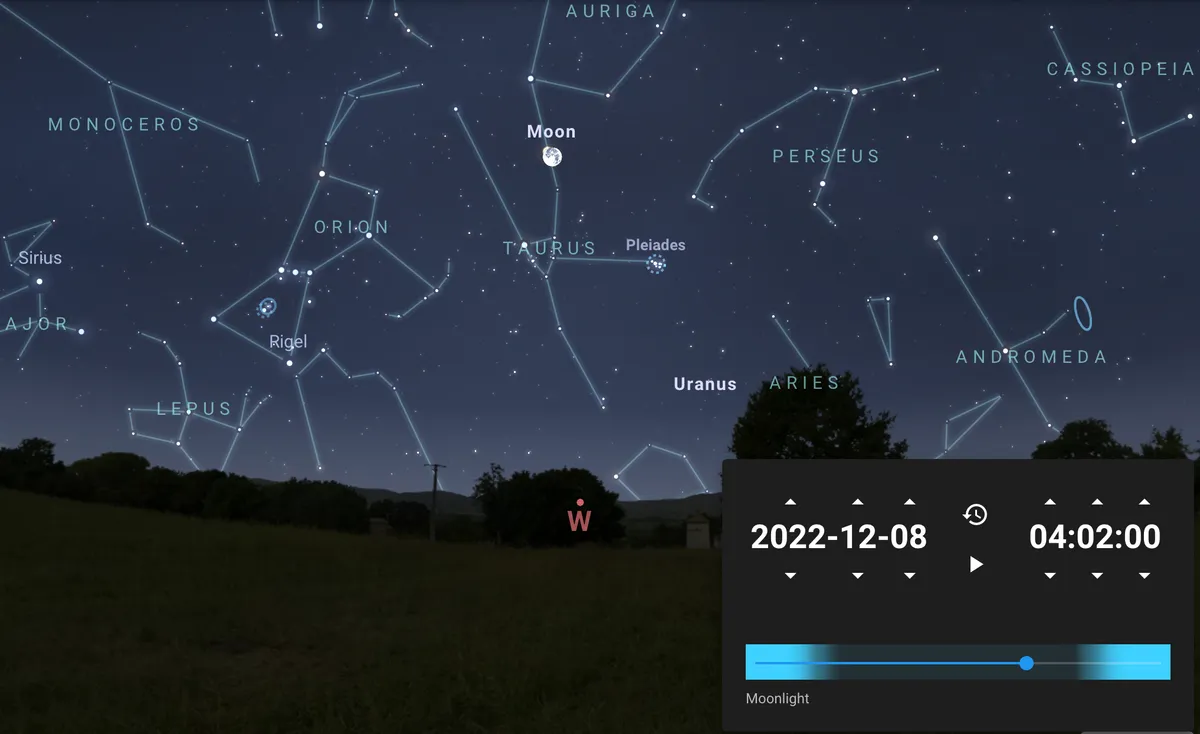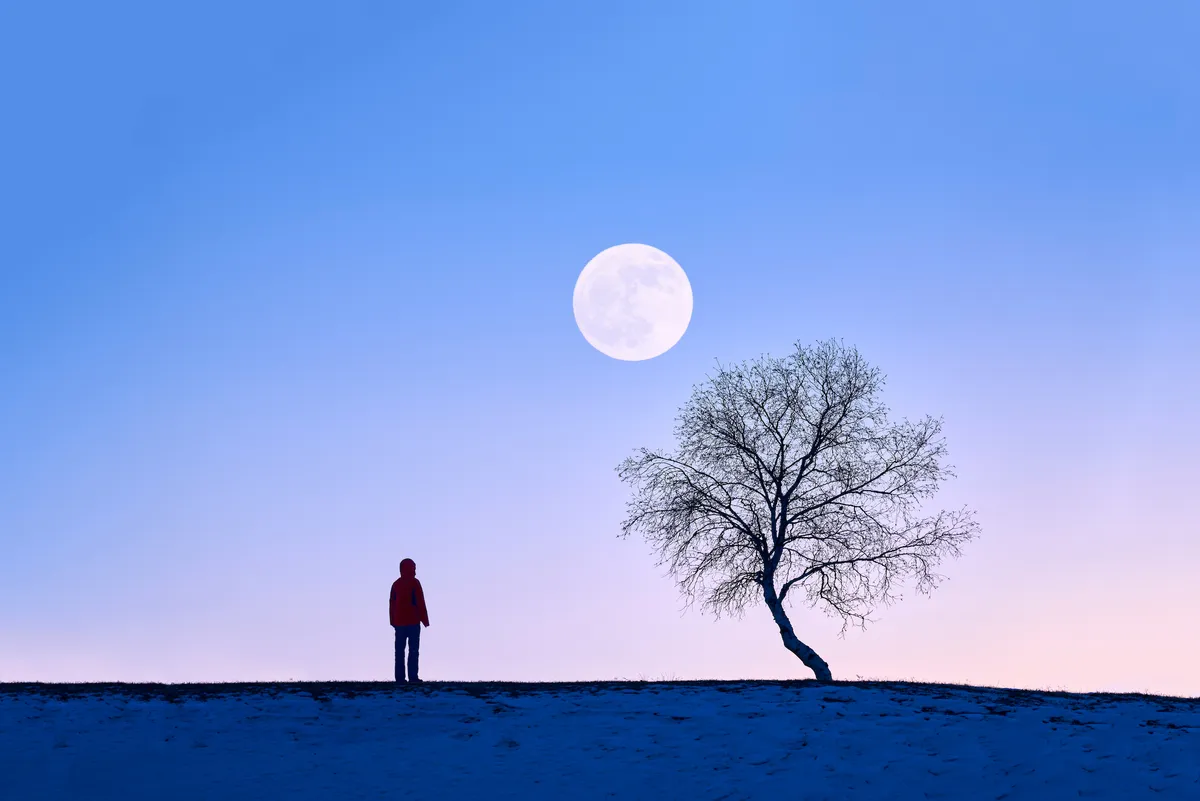December is one of the best months for stargazers; yes it's cold, but the rewards at this time of year are plentiful. As we approach the winter solstice, the shortest day, on 21 December 2022, there's a good chance of spotting a shooting star from one of the meteor showers, while a lunar occultation of Uranus happened on 5 December, with Mars taking its turn on 8 December.
Looking towards the northeast just after sunset, you'll be able to spot Mars at its biggest and brightest before it reaches opposition on the morning of the 8 December. As it rises, the Red Planet will travel east, and is clearly visible in the early evening sky, appearing as a bright yellow-orange point of light. It's easy to distinguish among the other planets and stars, so now is a great time to brave the cold for a glimpse of our celestial neighbour.
Make the most of clear skies with our full Moon UK calendarandastronomy for beginners guide. And, in case you missed it, we've pulled together the best pictures from the Artemis 1 launch.
When can I see the Cold Moon 2022?
The full Cold Moon will be visible tomorrow morning, Thursday 8 December 2022 in the UK and the northern hemisphere.
The Cold Moon will rise today, Wednesday 7 December in the northeast at 3:08pm, and will set the following morning at 8:29am in the northwest, on 8 November 2022 as seen from London (times vary with location).
The weather throughout November has been, well - terrible. So if the bad weather continues to spoil the occasion, or you are unable to see the full Cold Moon at its peak, it will also appear full the night before and after. In London, the forecast is currently looking relatively clear, with a few patchy clouds, so conditions - touch wood - are favourable for seeing both the full Moon and the lunar occultation of Mars, in the morning.
When is the best time to see the Cold Moon?
The Cold Moon will reach peak illumination at 4:02am GMT on the morning of Thursday 8 November, when it will be around 392,995km away from Earth.
Sunrise is at 7:52am on 8 December, so the best time to see the Cold Moon will be between 4am and 7am, as it lingers low on the horizon in a pre-dawn sky. The Moon will slip below the horizon at 8:29am.

What constellation is the Moon in?
Earlier in the month on the 2 December, when the Moon is in its waxing gibbous phase, it will be located around 2.5 degrees south of Jupiter in the constellation Pisces. Then, on the night of full, the Moon will be situated in Taurus, when it occults (moves in front of) Mars in opposition. Later, on 18 December, the Moon will have moved into Virgo, where it will be around 4.1 degrees north of the constellation's brightest object, a binary star system called Spica.
On Christmas Eve in the evening twilight, the Moon will pass just south of Mercury and Venus. However, as this happens at sunset, it's unlikely we'll be able to see the two planets at this time.
On Boxing Day, the Moon will have moved into Capricornus, and pass around 4 degrees south of Saturn, before catching up with Jupiter again on the 29 December.
Why is it called the Cold Moon?
Fairly unsurprisingly, many of the December names for the full Moon relate to temperature. Cold weather begins to descend on the northern hemisphere, and winter officially begins on the 21 December.
December's full Moon is also called the Long Night Moon or the Moon Before Yule, while some pagan traditions call it the Oak Moon, due to the tree's ability to cling on to its leaves during the cold, winter months.

Why do we always see the same side of the Moon?
The Moon has a 'near side' and a 'far side'. We can never see the far side from here on Earth, however, we're getting closer to uncovering some of the mysteries thanks to China's Chang'e-4 mission.
Although we can only see on side of the Moon, the Moon itself still rotates on its axis, and is synchronised with its orbit around us. Not surprisingly, this is called a 'synchronous orbit', and the Moon is in a 1:1 synchronous orbit around the Earth. This means it rotates once on its axis for each orbit it makes around the Earth, and therefore the same side always faces us.
And, because it rotates on its axis, all parts of the Moon have a day and night, just like on Earth. However, unlike Earth, lunar days and nights are around 14 Earth days long (half the lunar cycle).
Is the Cold Moon in 2022 a supermoon?
No, the Cold Moon in 2022 is not a supermoon.
A supermoon is an unofficial designation for when the Moon is situated 360,000km (or less) away from Earth in its orbital path. This occurs because the Moon is in a slightly elliptical orbit around the Earth, and it's more-or-less the same apparent size as the Sun.
It's usual to have two or three full supermoons in a row, and this year in 2022, the Strawberry Moon(June), theBuck Moon(July) and theSturgeon Moon(August) were all supermoons.
We will not see any more supermoons in 2022. The next supermoon will be on 1 August 2023, followed by a rare blue supermoon on 30 August 2023.
What causes a full Moon?
A full Moon is one part of the lunar cycle and occurs when the Moon is fully illuminated by the Sun. This happens when the Earth is positioned directly between the Sun and the Moon, and we usually have 12 full Moons in one calendar year, although in some years we can have 13.
At full, the Moon is precisely 180 degrees opposite the Sun in ecliptic longitude, when the Moon, Earth, and Sun are in a straight-line configuration.
Technically, the Moon is only 'full' for an instant (called syzygy), but it will appear full for the entire night. To our eyes, the Moon will also seem to be full for both nights on either side of the Cold Moon.
The lunar cycle takes 29 days, 12 hours, 44 minutes, and 3 seconds (generally, this is rounded to 29.53 days) to complete. That means we get a full Moon every 29.53 days. This figure is calculated by the time it takes the Moon to orbit the Earth once, as measured from new Moon to new Moon, and is also known as one synodic month.

Why do we sometimes have 13 full Moons in a single year?
Because one lunar cycle takes less than one calendar month to complete, we sometimes get 13 full Moons in a year. this phenomenon occurs approximately every two to three years. This means that we will see two full Moons in a single month; the extra full Moon being known as a ‘Blue Moon'. The next Blue Moon will occur on 30 August 2023.
Similarly, we sometimes get two new Moons in a month. This extra new Moon is known as aBlack Moon. The last Black Moon was 30 April 2022, and the next one will be next year, 19 May 2023.
Read more about the Moon: